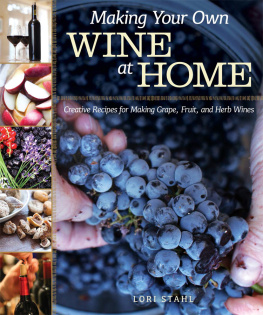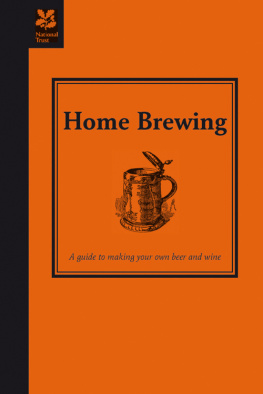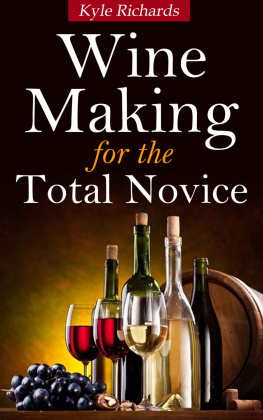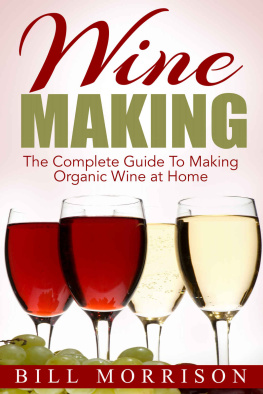Contents
Guide


Dedication
This book is dedicated to Jim and Sandy Witmyer:
My appreciation for sharing Coopers Hill Farm with me and the wisdom, bounty, and insights the two of you cultivated in your vineyard and wine supply business there. A sincere wish that this book will nurture winemakers as you have nurtured me.
This book is also dedicated to Katie Stahl: For being you and for enduring life in the fray of a mom whose winemaking transformed your home into a wine lab.

INTRODUCTION
This book is meant to serve as an invitation to and a companion for someone who has never made wine before and, perhaps, as a liberating inspiration to someone who has. If you are anything like I was, a curiosity and intrigue about this ancient art has grown insatiable, and adding yeast to your first batch of wine is inevitable. Ive written this book to hopefully give you the freedom to play at winemaking.
First, we will explore common tools, equipment, and ingredients used in winemaking. We will go through the steps of creating wine from a kit, then a concentrate. From there we will begin to jazz it up a bit, first adding fruit to a concentrate, then on to making wine from grapes, fruit, and even flowers and herbs. Ill encourage suggestions of ways to mix it up, and Ill share a few tales of wine-related adventures. We will visit markets, orchards, and an Amish ladys backyard in our quest for fruit. Ive tried to photograph as much as I could along the way, and yes, my camera did end up a little sticky, as I reached for it all too often amid fruit picking, grape crushing, and at every step of the process.
I hope to convey a bit of what was revealed to me of the rhythm of winemaking and tuning into the cycles of fermentation and of nature. Ill share every tip Ive discovered and even confess to some amusing blunders. Ill encourage that you create a community to share in your winemaking and your wine. Ill offer new twists on traditional recipes and sweet ways to enjoy, appreciate, and indulge in the wines you have created.
I hope this book encourages you to take the first steps on what has been a very enjoyable path for me, and I hope the first time you uncork your very first batch of wine, the aroma delights you and the liquid reveals to you the essence of that which you have fermented.


CONTENTS

Creative Ingredients for Delicious Wine
Get your adventure in winemaking started with the diverse array of recipes inside this book. Youll get the straight scoop on how to make wines from kits, concentrates, fresh fruit, and beyond. Whether your taste is Chardonnay, Riesling, or a funky fruit wine, youll love trying your hand at the 29 amazing recipes found in these pages.


Chapter 1
GETTING STARTED
Read up on the basics before you jump into winemaking to ensure your success and save you time and money. In this chapter, youll learn about winemaking equipment, essential and optional ingredients, typical winemaking techniques, and how to bottle, store, and label your finished masterpieces. Youll also get a special look at growing your own ingredients and meet five talented peoplefarmers, suppliers, chemists, and artistswho have worked some aspect of winemaking into their lives.


EQUIPMENT
First, you must familiarize yourself with some of the terminology, equipment, and ingredients used in winemaking. This may seem daunting, but fear not; a few basics are all you need to get started.
The basic equipment youll need for making wine is simple:
Bucket (to start your wine in, called a primary fermenter)
Jug (to finish your wine in, called a carboy or secondary fermenter)
Bottles and corks (to store your finished wine)
Clear tubing (a way to move your wine from container to container)
Airlock with bung (to protect your wine during fermentation)
Thermometer (very useful during fermentation)
Hydrometer (also useful during fermentation)

From left to right, back row: 5-gallon carboy, 6-gallon carboy, 3-gallon carboy; front row: 1-gallon jug/secondary fermenter, 1/2-gallon jug/secondary fermenter.
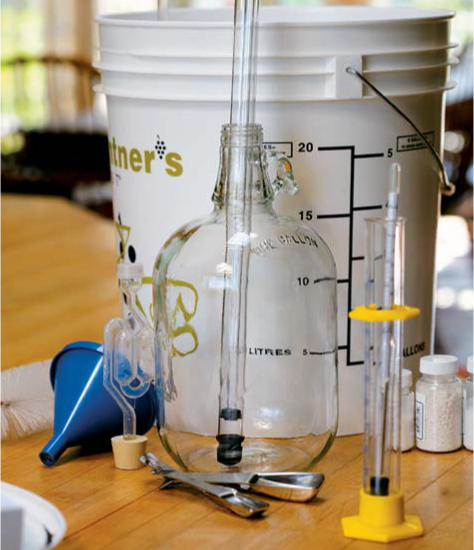
Equipment for home winemaking can be easily found and is not too expensive.
As you delve deeper into home winemaking, youll want to acquire other helpful tools, including a scale, measuring spoons that include a teaspoon (0.5mL), straining bags, a long stirring spoon, and a drill attachment with paddles. Other kitchen tools that can multitask for winemaking include potato mashers, measuring cups, and, of course, bottles, corks, corkscrews, and all sorts of clever tools for decanting and serving wine (more on that in , Enjoying Your Wine). Another useful tool is a heating pad. This unlikely tool can be really helpful if your winemaking space is not at an optimal temperature. On many a cold winters night Ive tucked one between two primary fermenters to help the yeast get off to a good start. As you progress in your winemaking, you should also add acid and pH test kits and filtration systems to your stash of tools.
Descriptions of common winemaking equipment follow. Some of these items will make more sense after youve read and understood the winemaking techniques. Refer back to this section as needed.
Winemakers journal
One of the most important pieces of winemaking equipment is the tablet, notebook, or journal that you dedicate to your winemaking activities. Write down information about your ingredients, your equipment, your successes, and your failures. Include anything that will help you improve your next batch.

